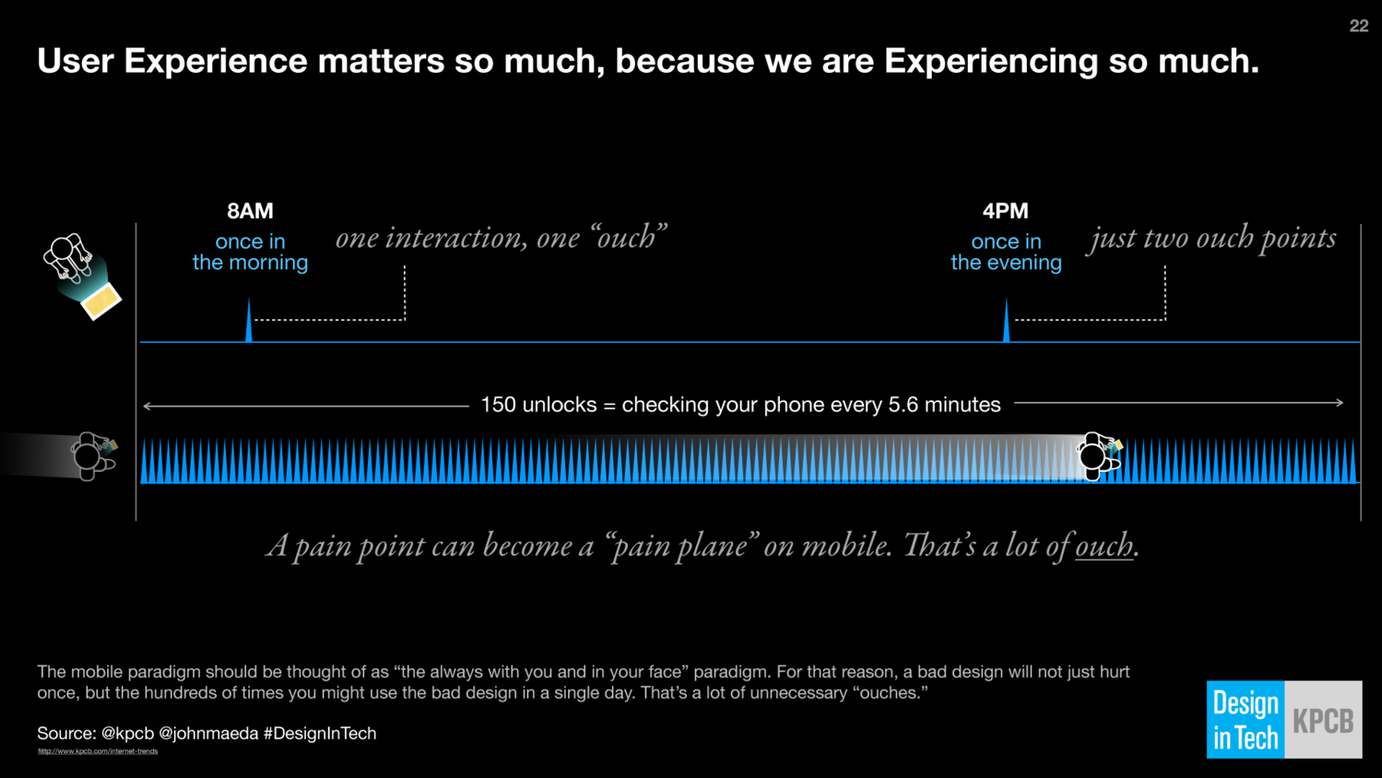Why Design Matters More than Moore
Friday, May 22nd 2015
From the beginning of the semiconductor industry a half-century ago, Moore’s Law has propelled Silicon Valley into the future. The impact of Gordon Moore’s observation that engineers learn how to double the number of transistors in an integrated circuit chip every 18 months without doubling the cost is astonishing. Today, however, with all of the computing power already at our fingertips, we’re discovering that ever-faster technology may matter far less than beautiful, intuitive, easy-to-use products and services. In short, we’re learning that design may matter more than Moore.
The transformative power of Moore’s Law.
Until the last few years, the solution to every new problem in tech has been simple: more technology. There’s a good reason for this. Computers, when first developed, had a fraction of the power they have today. For example, 15 years ago we were astonished to hear that the Furby toy had more computing power than the machines that launched the Apollo missions to space.
To put Moore’s Law, which recently celebrated its 50th anniversary, in context, 12 is 2, 22 is 4, 42 is 8, and 82 is 16. So in six years – which consists of four periods of Moore’s Law – you get a 16x increase. Make that 12 years and it’s a 256x increase. Make it 24 years and you get a 65,536x increase. And in 36 years? The increase is 8,388,608×. So next year, in 2016, you can expect the computer you’ll be using to be 8.3 million times more powerful than the one you were using in 1980. It’s just mind-boggling.
Just as you cannot imagine buying a car without design, we have entered an age in which you cannot buy tech without design.
Moore’s Law keeps going. Some experts say it will eventually be impossible to keep doubling every 18 months. Even if that happens, one thing we know is that this wouldn’t matter as much as it might have before. With the ubiquity of smartphones, powerful computing technology is now in the hands of the masses. The “computer for the rest of us” that the advertisements for the Macintosh had promised since 1984 has arrived. And that’s why Moore’s Law is no longer enough to make customers happy.
Moore’s Law is making way for design.
Old-guard techies were happy as long as computers got faster, which equated with “better.” But while regular users also appreciate speed, they appreciate experience even more. Imagine the decision to purchase two cars: The first is 10 times faster but highly uncomfortable to sit in, while the second operates well at the speed limit and is extremely comfortable to sit in and drive. If you’re a racecar driver, the former will appeal to you. But if, like most of us, you’re not, your heart will land with the second car.
Just as you cannot imagine buying a car without design, we have entered an age in which you cannot buy tech without design. That’s important for the entrepreneurs and investors who decide how to incorporate design into product development. Faster technology makes a marginal difference, but better design can create quantum leaps in customer satisfaction that distinguish the winners in the marketplace.
Consider this:
- Since 2010, 14 design agencies and 27 companies co-founded by designers have been acquired by giants such as Google, Facebook and Adobe.
- Five U.S.-based startups co-founded by designers have raised more than $2.75 billion.
- Six venture-capital firms have invited designers onto their teams — for the first time — in the last year.
The kind of design that increasingly matters today is led by a unique kind of design leader who understands the technology within which she designs, and the business goals that she needs to address to achieve financial success. Rochelle King, Spotify’s vice president of design, has an engineering background so she understands how to work with and within the constraints of technology. Furthermore, the design goals of her team members are tied to business objectives to ensure that every designer understands how their work impacts the bottom line.
A “tech company” makes technology – so it is no surprise the engineering mattered the most, especially when the only reason we’d buy a digital gadget or service was for reasons of faster, bigger or cheaper. Experience was an afterthought. The technology sold itself. Adding design at the very end of the development of a technology made perfect sense, as it could come at a minimal cost. However devices like the Nest thermostat illustrate a different approach, where design is baked in from the beginning. It looks like the addition of significant cost — or it looks like needed investment to create an exquisitely beloved product that could be acquired for $3.2 billion by Google.
I predict large tech companies will place greater attention on design. This is not dissimilar to the automobile industry as it began to mature — the famous point when Henry Ford refused to sell variations in the only color that mattered, compared with GM, which diversified its designs to appeal to larger populations across multiple brands like Chevrolet, Buick and Cadillac with differing emotional appeal. We see it already with Google’s efforts around Android’s enhanced “Material” visual language led by Matias Duarte, eBay’s design leadership efforts led by John Donahoe and IBM’s resurgence in the design space with its new Austin center led by Phil Gilbert. I outlined how these trends are reshaping Silicon Valley in my DesignInTech report (#DesignInTech).
Moore’s Law has changed the world through the work of generations of Silicon Valley engineers. Now, it has brought us to this unique moment in time – in which breakthrough design, partnering with breakthrough technology, has become the key to success.
